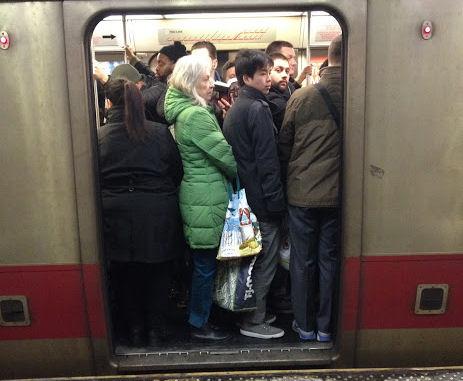September 22, 2016

MBTA officials pitched a solution for overcrowding and delays on the Red Line during a Monday meeting of the T's control board. File Photo/SHNS
The bustling Red Line, the MBTA’s busiest subway line, could transport an additional 10,000 passengers an hour and keep the time between trains to about three minutes if the agency upgrades the line’s entire fleet, according to T projections.
The 50 percent boost in capacity would mean less congestion, especially in the system’s downtown Boston core, for the 150,000 riders who rely on the Red Line to get where they’re going each day. And demand is on the rise as more housing is built near Red Line stations in Quincy, Dorchester and Cambridge’s white-hot Kendall Square market.
“We know the Red Line is booming, we know the Red Line needs more capacity,” Acting MBTA General Manager Brian Shortsleeve said on Monday. “I think one thing everyone agrees on is that more capacity on the Red Line is a good thing.”
MBTA Chief Operating Officer Jeff Gonneville said the current maximum capacity of the Red Line is 13 trains per hour -- carrying roughly 20,280 passengers -- with four-and-a-half to five-minute intervals between trains.
The T can’t change the distance between some stations and the numerous curves built into the Red Line’s track -- both of which limit how quickly trains can travel. But T officials said they want to tackle two other constraints: vehicle performance and the time trains sit idle at stations.
The allowable span between any two trains is determined by the distance it takes for a train to come to a complete stop, the T said. The signal system on the Red Line is based on the stopping distance of its “number 3” cars, which were put into service in the early 1990s, Gonneville said.
But by replacing all of its cars and making “minor speed code changes,” the Red Line could accommodate about 30,000 passengers per hour on 20 trains spaced about three minutes apart, Gonneville said.
The T is already in the process of replacing 132 of its roughly 220 Red Line cars by 2022. The new cars will be “number 4” type cars, which can travel faster for longer because they require 311 feet less than the current cars to come to a complete stop from 25 miles per hour, Gonneville said.
Gonneville asked the T’s Fiscal and Management Control Board on Monday to allow him and his team to dig deeper into the possibility of replacing the remainder of Red Line cars with new number 4 cars to facilitate the increase in capacity instead of moving forward with the current plan, which is to conduct “mid-life overhauls” of the older train cars.
“We’ve certainly seen that upgrading these vehicles with a more modern vehicle would have a substantial impact on our system performance,” Gonneville said.
Upgrading vehicles alone would not allow the T to increase capacity on the Red Line. The line’s capacity is also limited by station dwell times -- the amount of time a train sits idle at a station.
“The dwell times themselves are well beyond what we see in the industry, at least what we consider to be the industry average, about 45 seconds,” Gonneville said, adding that dwell times can approach two minutes during rush hours. “Those dwell times at a particular station actually have a great ripple effect across our system. If you can picture, the trains have to hold longer elsewhere and that really plays a significant part in our overall system reliability and certainly on our on-time performance.”
The T can take some steps immediately to reduce dwell times, Gonneville said, including having station attendants who assist drivers in determining when it is safe to shut the train doors become more active on the platforms.
Rider behavior also contributes to dwell times, and Gonneville said he plans to return to the T control board in “three to four weeks” with a presentation on a campaign to make riders more mindful of how their actions affect dwell times.
“We would like to work with our customers to begin talking about dwell times and some things we could do creatively to begin getting our dwell times down to that industry average,” he said.
Topics:



